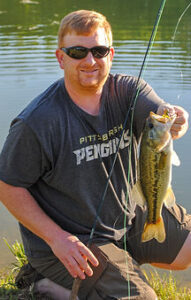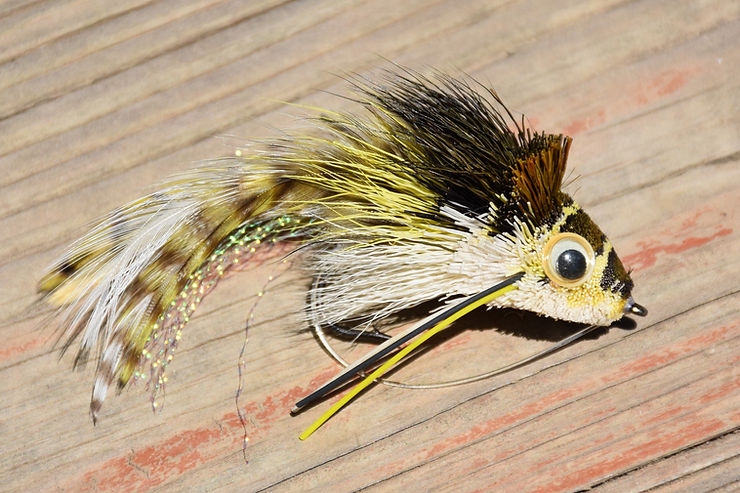Bass on the Fly: A Popper Primer

Bass thrive almost everywhere in the United States. Here in Pennsylvania, we’re fortunate to have generous populations of both largemouth and smallmouth in our lakes and rivers. No matter where bass are found, though, they all have one thing in common – they all like poppers.
Types of Poppers and Color Selection
Poppers come in a variety of styles: deer hair poppers, cup-faced poppers, flat-faced poppers, gliders, divers, and others. The main thing I consider when buying or tying a batch of poppers is the conditions that I’ll be fishing.
Sometimes, loud and obnoxious is best, and you have to really move water and cause a racket to get a bass’s attention. For instance, if there’s a good chop on the water, it’s going to take some effort to get the fish to look up and see your fly. Deer hair bugs and cup-faced poppers are designed to do just that. Other times, such as on highly-pressured waters or in the evening when there’s no chop on the water, you need something more subtle like a glider-style popper. The Sneaky Pete is a good example of this.
I’m ambivalent about the effectiveness of rubber legs. For largemouth bass, I feel like they’re a benefit. Largemouths, after all, are goofy bastards and will eat just about anything if they’re in the mood. But smallmouth bass, in my opinion, have more “trout tendencies” and prefer a more subtle presentation. That’s not to say you can’t catch smallmouth bass on poppers with rubber legs, because you can and I have, but they’re not my first choice.
An important factor to remember when buying or tying poppers is this: these aren’t trout flies. You don’t need a huge variety to match any type of hatch. A good selection can be very basic: a cup-faced popper with and without rubber legs, a couple colors of gliders, a diver (the Dahlberg Diver is an awesome bass fly), and perhaps some type of deer hair bug can cover a wide variety of situations.

The rule of thumb for color selection is the same for poppers as it is for most fly choice. On dark, cloudy days, a dark-colored popper will usually work best. On bright, sunny days, a bright-colored fly should be the first choice.
Also consider the habitat and forage base where you’re fishing. For instance, in a pond or lake with lots of lily pads and frogs, a frog-colored popper is a go-to regardless of weather conditions. Certain colors, such as yellow or chartreuse, are mainstays, too, and can work any time. If I’m on a lake where the main baitfish are shad, shiners, alewives, or similar forage, then I’m definitely carrying poppers with some silver and black on them.
Casting Poppers
The first step in fishing bass poppers is using a fly rod with enough power to cast them. Poppers can be heavy and trout-weight fly rods don’t have the backbone to cast them effectively. A 9-foot fly rod in the 6- to 7-weight range will work if you don’t have to cast far to reach structure. Overall, though, an 8- or 9-weight will make casting easier, especially on windy days, as well as perform better during the actual hooking and fighting of the fish.
Casting a bass popper is not easy and requires more physical effort than casting most trout flies. There’s no such thing as a delicate, beautifully-looped cast. Compared to tiny dry flies, casting a popper is like trying to sling a refrigerator. However, because the poppers themselves are heavy and wind resistant, you have to be more patient and allow the line to unfurl all the way in front and behind you while false casting to avoid snapping them off.
Another tip for casting these clunky flies is to position yourself with one foot slightly in front of the other and rock back and forth slightly as you false cast forward and then backward. This transfer of weight from foot to foot takes emphasis off of your arm action and allows you to use more of your body.
Imparting Action
Fishing poppers requires very little finesse. Point the rod tip toward the popper and strip line while twitching the rod to the left or right, which creates the “pop.” There’s no right or wrong way to fish a popper in terms of retrieval speed.
Most times, it’s a matter of determining how aggressive the fish are that particular day. If the fish are in attack mode, I like a fast retrieve – two or three strips and twitches and then a pause. If they seem more sluggish, a slow and subtle retrieve seems to work best – one strip and twitch and then pause.
The most important part of the retrieve, regardless of speed, is the pause. Let the fly sit still for 5-10 seconds (and occasionally even 15-20 seconds) before inducing more action. Most strikes occur when the fly is stationary.
Bass are hard-lipped fish and it takes a sharp hook and a solid set to hook them. Don’t be tentative when setting the hook. A soft hook set will result in a loss almost every time. If you’ve watched any of the professional bass fishermen on television, you’ll notice that when they get a strike they really rear back on the rod, fast and hard. When using a fly rod, this is especially critical because it has more give than traditional spinning gear. For this reason, I use heavier leaders in the 0x-2x range (10-15 pound test) and very rarely use a tippet.
Bass aren’t all that picky or line shy. I haven’t noticed any significant difference in catch ratios from one size leader to another, so I use heavier leaders so that I don’t have to worry about breaking off on the hook set.
Stalking Bass in Ponds and Lakes
When I’m fishing ponds, I like a spot and stalk style of bass fishing. Staying far enough from the water’s edge to avoid spooking fish, I find the shallow, vegetated flats where bass like to cruise. If a fish is up and moving, it’s likely hungry and can be caught. When I see a bass in the shallows, I estimate its course and try to land the popper a few feet in front of its nose. Many times, just the disturbance of the popper hitting the water is enough to incite strikes. That’s what I like about bass. They hit as much out of aggression and impulse as they do hunger.
In deeper parts of ponds, I fish parallel to the bank, casting out ahead as I move around the pond. Sometimes I’ll fish perpendicular just for the sake of covering as much water as possible, but most of the biters can be found close to shore where they set up ambush for any bug, frog, or food source that finds its way into the water.

(Photo: This Dahlberg Diver came with a weed guard. Sometimes I snip off the weed guard because it can cause misses and lost fish. There are few situations where the weed guard is really necessary anyway.)
When fishing lakes, I look for structure such as lily pads and trees in the water. Many bass poppers are available with weedless hooks, but I don’t think they’re necessary. Most of the time I fish the edges of the weeds and lily pads anyway because if I hook a fish in the weeds, I know it’s going to be next to impossible to power it out of there with just a fly rod. In my opinion, weedless hooks are valuable when fishing ponds that have a lot of surface debris on them. The weed guard keeps you from having to clean debris from the hook after every retrieve.
There’s a reason why bass are considered one of the top gamefish today. They strike hard, fight hard, and can be found almost anywhere in the country. And they make a great quarry once the water warms up too much to pursue trout. What’s not to love?
Sign up for the Dark Skies Fly Fishing e-newsletter
It's free, delivered to your inbox approximately three times each month. Your information is always kept private and used for the sole purpose of keeping you up to date on blog posts and specials in the online store.
Sign Up Now